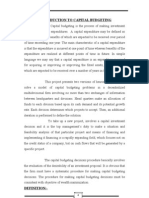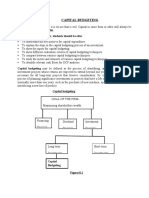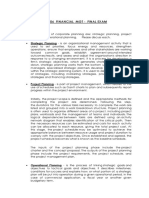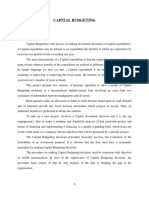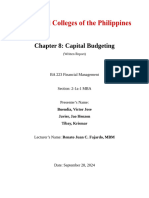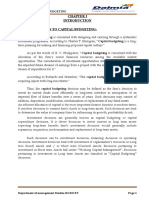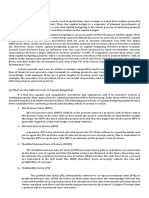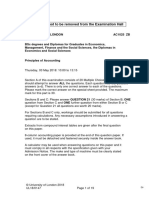Capital Budgeting Addresses The Issue Ofstrategic Long-Term Investment
Capital Budgeting Addresses The Issue Ofstrategic Long-Term Investment
Uploaded by
Bryan LluismaCopyright:
Available Formats
Capital Budgeting Addresses The Issue Ofstrategic Long-Term Investment
Capital Budgeting Addresses The Issue Ofstrategic Long-Term Investment
Uploaded by
Bryan LluismaOriginal Description:
Original Title
Copyright
Available Formats
Share this document
Did you find this document useful?
Is this content inappropriate?
Copyright:
Available Formats
Capital Budgeting Addresses The Issue Ofstrategic Long-Term Investment
Capital Budgeting Addresses The Issue Ofstrategic Long-Term Investment
Uploaded by
Bryan LluismaCopyright:
Available Formats
BRYAN T.
LLUISMA FIN 3
BSA-4 TTH 5-6:30PM
1. WHAT IS CAPITAL BUDGETING?
Capital budgeting addresses the issue ofstrategic long-term investment
decisions.
Capital budgeting can be defined as the process of analyzing, evaluating,
and deciding whether resources should be allocated to a project or not.
Process of capital budgeting ensure optimal allocation of resources and
helps management work towards the goal of shareholder wealth
maximization.
2. SIGNIFICANCE OF CAPITAL BUDGETING
Capital budgeting is important because it creates accountability and
measurability. Any business that seeks to invest its resources in a project
without understanding the risks and returns involved would be held as
irresponsible by its owners or shareholders.
Furthermore, if a business has no way of measuring the effectiveness of its
investment decisions, chances are the business would have little chance of
surviving in the competitive marketplace.
Businesses (aside from non-profits) exist to earn profits. The capital budgeting
process is a measurable way for businesses to determine the long-term
economic and financial profitability of any investment project.
A capital budgeting decision is both a financial commitment and an
investment. By taking on a project, the business is making a financial
commitment, but it is also investing in its longer-term direction that will likely
have an influence on future projects the company considers.
3. EXPLAIN PROJECT CLASSIFICATION
1. Replacement: One category consists of expenditure to replace worn-out
or damaged equipment used in the production of profitable products.
Replacement projects are necessary if the firm is to continue in business.
2. Replacement: Cost reduction. This category includes expenditures to
replace serviceable but obsolete equipment. The purpose here is to lower the
costs of labor, materials, and other inputs such as electricity.
3. Expansion of existing products or markets.
Expenditures to increase output of existing products, or to expand retail
outlets or distribution facilities in markets now being served, are included here.
4. Expansion into new products or markets.
These are investments to produce a new product or to expand into a
geographic area are not currently being served.
5. Safety and/or environmental projects-expenditures necessary to comply
with government orders, labor agreements, or insurance policy terms fall into this
category.
4. STEPS IN CAPITAL BUDGETING
1. Estimate CFs (inflows & outflows).
2. Assess riskiness of CFs.
3. Determine the appropriate cost of capital (%).
4. Find NPV ($), IRR (%) and/or MIRR (%).
5. Accept if NPV > 0 and/or IRR > WACC.
5. FIVE KEY METHODS ARE USED TO RANK PROJECTS IN THE CAPITAL
BUDGET
1. Payback
2. Discounted payback
3. Net present value(NPV)
4. Internal Rate of return(IRR)
5. Modified internal rate of return
6. THE DIFFERENCE BETWEEN INDEPENDENT AND MUTUALLY ECLUSIVE
PROJECTS.
Independent projects – if the cash flows of one are unaffected by the
acceptance of the other – more than one project may be accepted.
Mutually exclusive projects – if the cash flows of one project can be
adversely impacted by the acceptance of the other – accept one or the other.
7. PAYBACK PERIOD
The length of time required for an investment’s net revenues to cover its
cost. Defined as the expected number of years required to recover the original
investment, was the first formal method used to evaluate capital budgeting
projects.
The payback period refers to the amount of time it takes to recover the cost
of an investment or how long it takes for an investor to reach breakeven.
8. NET PRESENT VALUE (NPV)
is the sum of the present values of the cash inflows and outflows.
You might also like
- New Heritage Doll CaseDocument9 pagesNew Heritage Doll Caseapi-30934141185% (13)
- Chapter-3: Capital Budgeting Chapter-Three Capital Budgeting/Investment Decision 3.1. Definition of Capital BudgetingDocument12 pagesChapter-3: Capital Budgeting Chapter-Three Capital Budgeting/Investment Decision 3.1. Definition of Capital Budgetingmalik macNo ratings yet
- Capital Budgeting PDFDocument10 pagesCapital Budgeting PDFSenthil KumarNo ratings yet
- Long Term Inv + FundamentalsDocument13 pagesLong Term Inv + Fundamentalssamuel kebedeNo ratings yet
- Capital Budgeting Decision: NPV Vs Irr Conflicts and ResolutionDocument18 pagesCapital Budgeting Decision: NPV Vs Irr Conflicts and Resolutionnasir abdulNo ratings yet
- Topic 3-Investment Decisions (Capital Budgeting) - Investment Appraisals TechniquesDocument12 pagesTopic 3-Investment Decisions (Capital Budgeting) - Investment Appraisals Techniquesngezerojas57No ratings yet
- FM Unit-3 CBDocument27 pagesFM Unit-3 CBashokdgaurNo ratings yet
- Chapter 5 - Capital BudgetingDocument34 pagesChapter 5 - Capital Budgetingabegail g. madriagaNo ratings yet
- Ajith ProjectDocument89 pagesAjith ProjectAnonymous MhCdtwxQINo ratings yet
- Define Capital Budgeting: Qualitative CriteriaDocument12 pagesDefine Capital Budgeting: Qualitative Criteriastannis69420No ratings yet
- Chapter One: Capital Budgeting Decisions: 1.2. Classification of Projects Independent Verses Mutually Exclusive ProjectsDocument25 pagesChapter One: Capital Budgeting Decisions: 1.2. Classification of Projects Independent Verses Mutually Exclusive ProjectsezanaNo ratings yet
- Capital Budgeting - Chaitanya ChemicalsDocument63 pagesCapital Budgeting - Chaitanya ChemicalsNani RoyalNo ratings yet
- Capital BudgetingDocument5 pagesCapital Budgetingayush dhimanNo ratings yet
- Capital BudgetingDocument22 pagesCapital BudgetingBonas TowoNo ratings yet
- CHAPTER-1 Introduction: 1.1 Overview 1.2 Meaning of Capital BudgetingDocument15 pagesCHAPTER-1 Introduction: 1.1 Overview 1.2 Meaning of Capital BudgetingPratibha NagvekarNo ratings yet
- Unit 3 - Scoman2Document10 pagesUnit 3 - Scoman2christian guile figueroaNo ratings yet
- Chapter - IDocument65 pagesChapter - Iarjunmba119624No ratings yet
- FM 1 CH 4 (Lti) My MLC ExtDocument19 pagesFM 1 CH 4 (Lti) My MLC ExtMELAT ROBELNo ratings yet
- Abstract CAPITAL BUDGETING UltratechDocument12 pagesAbstract CAPITAL BUDGETING UltratechraghunathreddychallaNo ratings yet
- Project ApraissalDocument19 pagesProject ApraissalPremchandra GuptaNo ratings yet
- BFIN AssignmentDocument7 pagesBFIN AssignmentHon Rep Shadrach BrownNo ratings yet
- Capital BudgetingDocument93 pagesCapital BudgetingKhadar100% (3)
- Project On Capital BudgetingDocument59 pagesProject On Capital BudgetingRahiman NoufalNo ratings yet
- Capital BudgetingDocument64 pagesCapital BudgetingNiaz Ahmed100% (1)
- APGENCO - Capital BudgetingDocument73 pagesAPGENCO - Capital Budgetingkrishna saiNo ratings yet
- Investment Appraisal MethodsDocument15 pagesInvestment Appraisal MethodsFaruk Hossain100% (1)
- Final Exam Doc Cel SaberonDocument4 pagesFinal Exam Doc Cel SaberonAnonymous iScW9lNo ratings yet
- Capital BudgetingDocument65 pagesCapital Budgetingarjunmba119624No ratings yet
- University of Mumbai Study of Capital BudgetingDocument84 pagesUniversity of Mumbai Study of Capital BudgetingOmkar GaikwadNo ratings yet
- Project Unit 1 & 2Document14 pagesProject Unit 1 & 2bogartshitu09No ratings yet
- 54 Capital BudgetingDocument4 pages54 Capital BudgetingCA Gourav JashnaniNo ratings yet
- Fundamentals of Capital Budgeting: Learning Packet 1Document17 pagesFundamentals of Capital Budgeting: Learning Packet 1jenniferNo ratings yet
- A Study On Capital Budgeting.Document15 pagesA Study On Capital Budgeting.Kumar SwamyNo ratings yet
- Capital BudgetingZuari CementsDocument74 pagesCapital BudgetingZuari CementsAnusha ReddyNo ratings yet
- FM Unit 2 CB Part B QaDocument6 pagesFM Unit 2 CB Part B QaVasugi KumarNo ratings yet
- Soap Industry in Capital BudgetingDocument63 pagesSoap Industry in Capital BudgetingShivam Panday0% (1)
- 1cm8numop 728793Document91 pages1cm8numop 728793Deepak AroraNo ratings yet
- Capital Budgeting-Research FinalDocument22 pagesCapital Budgeting-Research FinalNour Fawaz100% (1)
- Capital Budgeting Modify 1Document72 pagesCapital Budgeting Modify 1bhaskarganeshNo ratings yet
- Report CCCCDocument107 pagesReport CCCCUtkarsh BajpaiNo ratings yet
- Chap 1Document5 pagesChap 1Cẩm ChiNo ratings yet
- M4 - M2 - Capital Budgeting and Risk AnalysisDocument39 pagesM4 - M2 - Capital Budgeting and Risk Analysisarvind sharmaNo ratings yet
- Chapter 8 Capital Budgeting-Written Report (Buendia, Javier, Tibay)Document17 pagesChapter 8 Capital Budgeting-Written Report (Buendia, Javier, Tibay)ram tibayNo ratings yet
- UntitledDocument12 pagesUntitledPikki LovarajuNo ratings yet
- Finance ProjectDocument45 pagesFinance ProjectVINAY KumarNo ratings yet
- Management of Capital BudgetingDocument4 pagesManagement of Capital BudgetingMuhammad Furqan AkramNo ratings yet
- FM CH 6 Investment Decision and Capital Budgeting AutosavedDocument40 pagesFM CH 6 Investment Decision and Capital Budgeting AutosavedIliyas IsakeNo ratings yet
- Fundaments of Financial ManagementDocument13 pagesFundaments of Financial ManagementAadheesh SoodNo ratings yet
- Module 2 - Analysis and Techniques of Capital BudgetingDocument42 pagesModule 2 - Analysis and Techniques of Capital Budgetinghats300972No ratings yet
- RABARA - Capital ManagementDocument2 pagesRABARA - Capital Managementjhon rayNo ratings yet
- Bac204 Lesson 111 E-NotesDocument25 pagesBac204 Lesson 111 E-NotesRuth WanguiNo ratings yet
- Bba FM Notes Unit IiiDocument7 pagesBba FM Notes Unit IiiSunita SehgalNo ratings yet
- Project Chapter 1 EditedDocument18 pagesProject Chapter 1 Editedsamuel debebeNo ratings yet
- Capital Budgeting ResearchDocument21 pagesCapital Budgeting ResearchNour FawazNo ratings yet
- Lession 0003Document15 pagesLession 0003Dr Suman RamapatiNo ratings yet
- Capital Budgeting NotesDocument46 pagesCapital Budgeting NotesShilpa Arora NarangNo ratings yet
- Capital BudgetingDocument68 pagesCapital BudgetingPranay GNo ratings yet
- 08 Chapter 2Document38 pages08 Chapter 2Bryan GonzalesNo ratings yet
- Capital Budgeting Project ReportDocument24 pagesCapital Budgeting Project Reportnishiit92% (12)
- An Overview of Capital BudgetingDocument3 pagesAn Overview of Capital BudgetingChristene Grava TenebrosoNo ratings yet
- Emmanuel'S Resort: Samay, BalingasagDocument4 pagesEmmanuel'S Resort: Samay, BalingasagBryan LluismaNo ratings yet
- Brief Description Emmanuels'S Spring ResortDocument1 pageBrief Description Emmanuels'S Spring ResortBryan LluismaNo ratings yet
- Emmanuel'S Resort: Samay, BalingasagDocument4 pagesEmmanuel'S Resort: Samay, BalingasagBryan LluismaNo ratings yet
- Strategic Management Models: The Resurgence of ModelsDocument2 pagesStrategic Management Models: The Resurgence of ModelsBryan LluismaNo ratings yet
- MNGT 7 Business PolicyDocument6 pagesMNGT 7 Business PolicyBryan LluismaNo ratings yet
- Bryan T. Lluisma Fin 3 BSA-4 TTH 5:00-6:30PM Prelim ExamDocument4 pagesBryan T. Lluisma Fin 3 BSA-4 TTH 5:00-6:30PM Prelim ExamBryan LluismaNo ratings yet
- Semi-Finals Fin 3Document3 pagesSemi-Finals Fin 3Bryan Lluisma100% (1)
- An Example of Personal Finance Is Debating Whether or Not To Save Five DollarsDocument3 pagesAn Example of Personal Finance Is Debating Whether or Not To Save Five DollarsBryan LluismaNo ratings yet
- NOPAT NOPAT2011 - NOPAT20010 (Note ' MeansDocument5 pagesNOPAT NOPAT2011 - NOPAT20010 (Note ' MeansBryan LluismaNo ratings yet
- Chapter 6 MNGT 4Document27 pagesChapter 6 MNGT 4Bryan LluismaNo ratings yet
- Fin3 Midterm ExamDocument8 pagesFin3 Midterm ExamBryan Lluisma100% (1)
- Acctg 16B Assgn 2Document2 pagesAcctg 16B Assgn 2Bryan LluismaNo ratings yet
- Bryan T. Lluisma Acctg16B BSA-4 SAT 6-9PMDocument1 pageBryan T. Lluisma Acctg16B BSA-4 SAT 6-9PMBryan LluismaNo ratings yet
- Chap 13 Problem SolutionsDocument31 pagesChap 13 Problem SolutionsBryan LluismaNo ratings yet
- Financial Management at Beacon Pharmaceuticals LimitedDocument24 pagesFinancial Management at Beacon Pharmaceuticals LimitedFarhanUddinAhmedNo ratings yet
- Analyzing MCS of New & Ongoing ProgrammeDocument34 pagesAnalyzing MCS of New & Ongoing ProgrammeAnushka MadanNo ratings yet
- FS SWM WTE Greater MalangDocument316 pagesFS SWM WTE Greater MalangBenny Aryanto SihalohoNo ratings yet
- Unit 7Document31 pagesUnit 7mokeNo ratings yet
- Profile On The Production of Leather Goods PDFDocument28 pagesProfile On The Production of Leather Goods PDFsetegn100% (1)
- Unit 2 Problem SheetDocument9 pagesUnit 2 Problem SheetTejas ArgulewarNo ratings yet
- Financial Analysis InsDocument56 pagesFinancial Analysis InsAbebe TilahunNo ratings yet
- CF - Section A - DR - Sudhindra BhatDocument5 pagesCF - Section A - DR - Sudhindra BhatAbarna LoganathanNo ratings yet
- Case01 02Document24 pagesCase01 02Sakshi SharmaNo ratings yet
- CHAPTER 9 - Investment AppraisalDocument37 pagesCHAPTER 9 - Investment AppraisalnaurahimanNo ratings yet
- Chapter 8 QuestionsDocument7 pagesChapter 8 QuestionsJason FischerNo ratings yet
- RCSA 103020A - Energy Analysis Report (Rev 5)Document36 pagesRCSA 103020A - Energy Analysis Report (Rev 5)adeel_jamelNo ratings yet
- Amara Raja Batteries LTD Tirupathi: Narayana Engineering CollegeDocument19 pagesAmara Raja Batteries LTD Tirupathi: Narayana Engineering CollegeBhuvana Analapudi100% (1)
- Final Paper 1 - SolutionDocument14 pagesFinal Paper 1 - Solutionishujain007No ratings yet
- Economic Evaluation and Sensitivity-Risk Analysis - GoldDocument7 pagesEconomic Evaluation and Sensitivity-Risk Analysis - GoldSwapnendu GoonNo ratings yet
- Business Finance Ch4Document60 pagesBusiness Finance Ch4mohfarid150No ratings yet
- Net Present Value and Other Investment Criteria: Solutions To Questions and ProblemsDocument4 pagesNet Present Value and Other Investment Criteria: Solutions To Questions and Problemsabraha gebruNo ratings yet
- 104 AssDocument4 pages104 AssJohanne CasiresNo ratings yet
- Multiple Choice Questions On Capital BudgetingDocument2 pagesMultiple Choice Questions On Capital BudgetingRohit Shrivastav100% (7)
- 2018 ZBDocument19 pages2018 ZBameziya adoraNo ratings yet
- Chapter 3 Project AppraisalDocument23 pagesChapter 3 Project Appraisaljonathan josiahNo ratings yet
- Finance - Self Study Guide For Staff of Micro Finance InstitutionsDocument9 pagesFinance - Self Study Guide For Staff of Micro Finance InstitutionsmhussainNo ratings yet
- Multiple Projects and ConstraintsDocument2 pagesMultiple Projects and ConstraintsHamza100% (1)
- Strategic Financial ManagementDocument5 pagesStrategic Financial Managementranjitghosh684No ratings yet
- Value Averaging SSRNDocument41 pagesValue Averaging SSRNJohn ChewNo ratings yet
- Acc 223 CB PS3 QDocument8 pagesAcc 223 CB PS3 QAeyjay ManangaranNo ratings yet
- Solved Paul Company Includes Three Coupons in Each Package of CrackersDocument1 pageSolved Paul Company Includes Three Coupons in Each Package of CrackersM Bilal SaleemNo ratings yet
- Cotton YarnDocument26 pagesCotton YarnAbebaw SirajNo ratings yet
- Tugas Kelompok 5 - Studi Kasus Franklin LumberDocument30 pagesTugas Kelompok 5 - Studi Kasus Franklin LumberAgung Iswara100% (1)





















